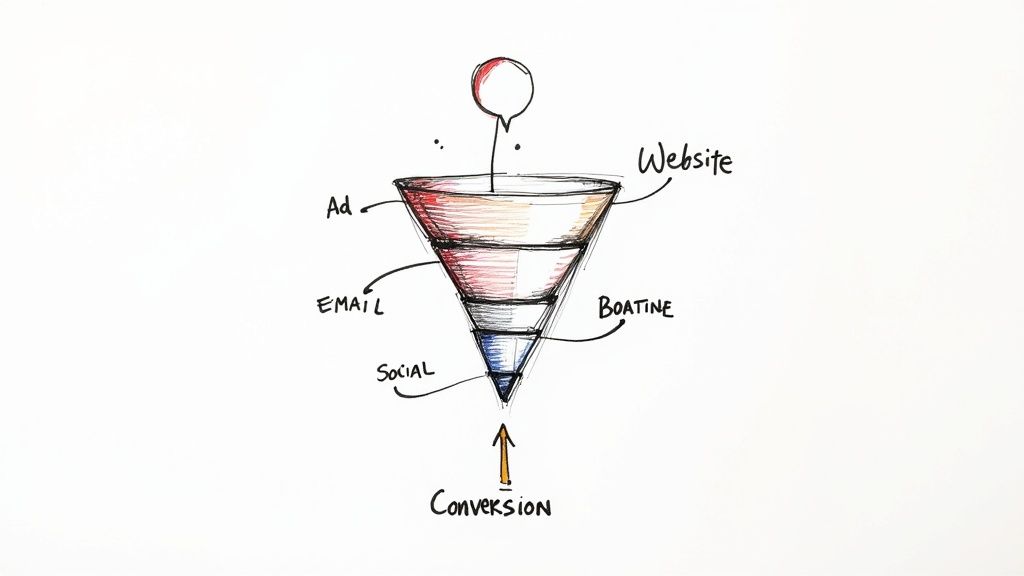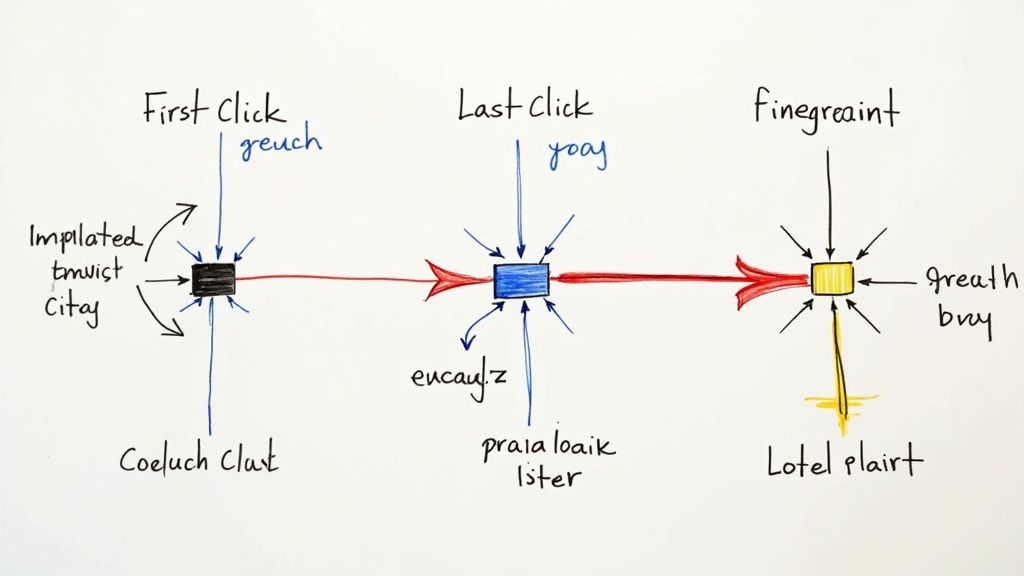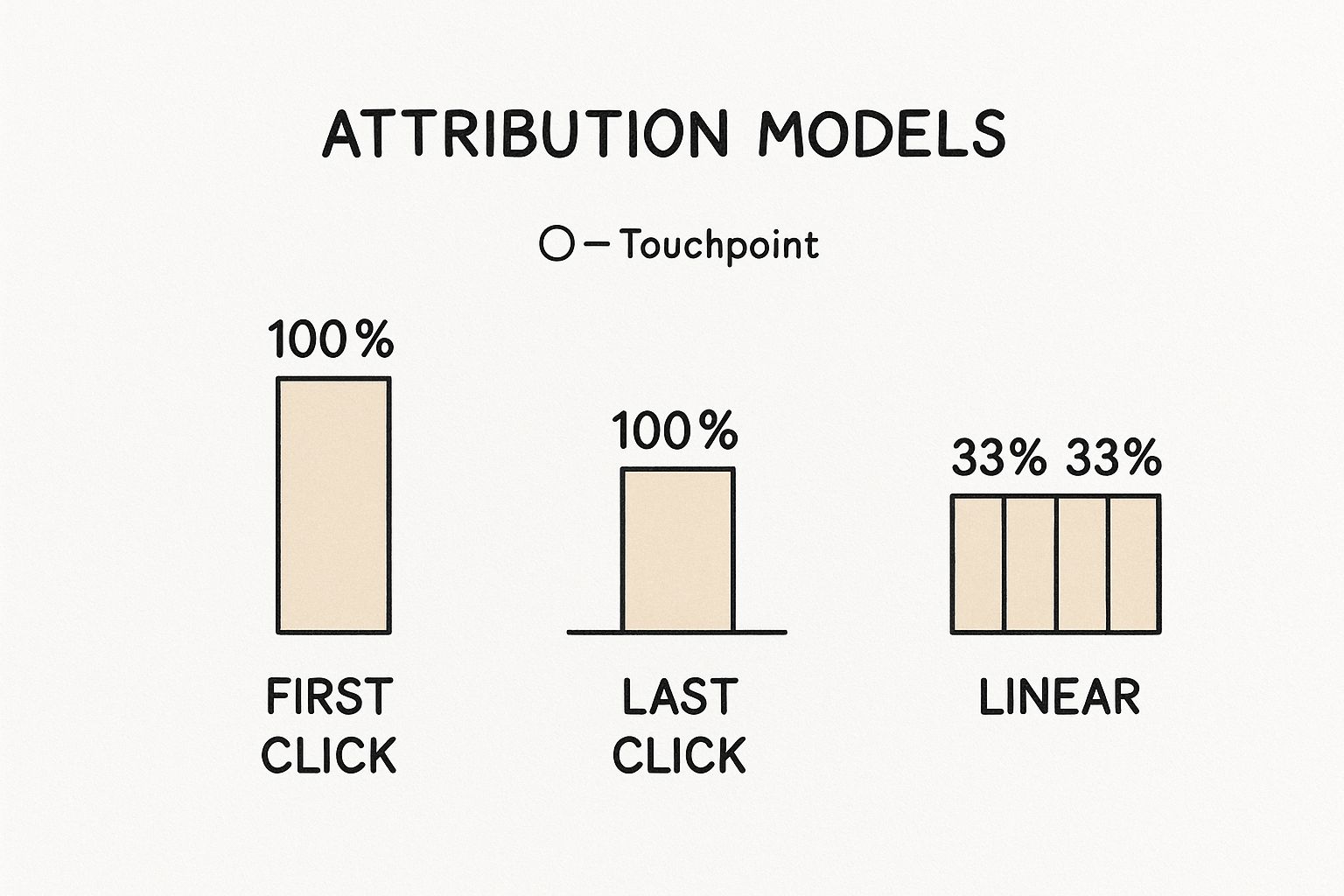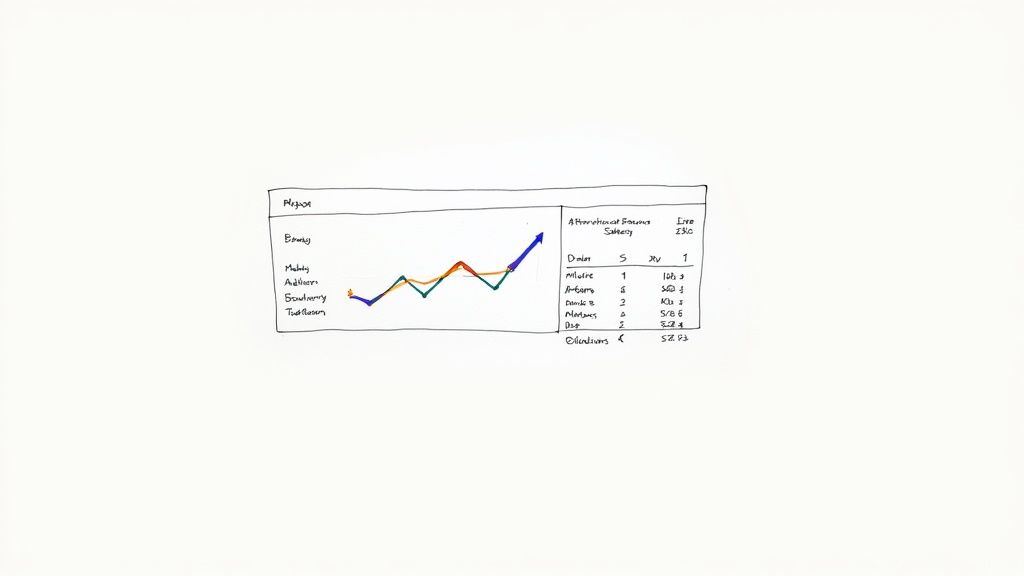What Is Attribution Modeling? A Marketer's Guide
Attribution modeling is just a fancy way of giving credit where it's due. It’s how you figure out which marketing touchpoints—the ads, emails, and content a customer sees—actually pushed them to buy.
Stop guessing what's working. Start knowing.
Why Your Marketing Is Flying Blind Without Attribution

Ever feel like you’re just throwing money at marketing campaigns, hoping something sticks? You're not alone. That exact feeling is the problem attribution modeling was built to solve. It turns your strategy from wishful thinking into one backed by hard data.
Think of your marketing like a soccer team. Giving all the credit to the person who scored the goal (the last click) is a rookie mistake. It ignores the killer passes and assists that made the goal possible.
Attribution modeling is your marketing's instant replay. It doesn't just show you who scored; it reveals the entire sequence of plays, highlighting every valuable move along the way.
This shift is critical. Customer journeys are messy. In fact, over 50% of customer journeys involve multiple touchpoints across different channels before a sale happens. Someone might find your brand on Instagram, read a blog post from Google, and finally buy from a retargeting ad a week later.
Prove Value and Optimize Spend—Fast
Without a clear view of that path, you’re flying blind. You might slash the budget for your blog because it doesn't seem to drive direct sales, completely missing that it’s your most powerful tool for attracting high-value customers.
Attribution modeling gives you the clarity to make smarter calls. It helps you:
Justify Marketing Spend: Show stakeholders exactly how your activities make money.
Optimize Your Budget: Shift cash from channels that aren't pulling their weight to the ones that are.
Improve Customer Experience: Understand the paths people take so you can make their journey smoother.
Ultimately, attribution connects your actions to your results. It’s the foundation for unlocking the key benefits of data-driven decision-making. With a solid model, you can finally measure your marketing ROI with real precision.
The Journey From Simple Guesses To Smart Insights

The drive to figure out what marketing actually works isn't new. It’s just gotten a whole lot smarter. Long before clicks and pixels, marketers wrestled with the exact same question: how do we know our budget is making a difference?
Imagine trying to connect a national TV ad to a sales spike three months later. It was a puzzle of massive, disconnected pieces.
This led to the first real measurement techniques, like Marketing Mix Modeling (MMM). Think of it like looking at a city from an airplane—you see big-picture patterns, but you have no idea what specific routes individual cars are taking. MMM was a game-changer, but it had one giant blind spot: the individual customer.
The Problem of Double-Counting
As more channels popped up, that lack of detail created chaos. Different teams ran campaigns at the same time, and every single one wanted to claim full credit for the same sale. This wasn't just ego; it was a financial nightmare.
The DNA of modern attribution comes from these methods, but the desperate need for it became obvious. A classic case from the 1990s involved a bank that discovered, on average, each dollar of revenue was being claimed by seven different marketing campaigns. It was a messy, inefficient free-for-all. You can read more about the long, winding history of attribution on Skip Fidura’s blog.
The core problem wasn't a lack of effort; it was a lack of precision. Without a system to assign credit fairly, marketers were working in silos, unable to see how their efforts truly influenced each other.
From Broad Strokes to Fine Lines
Then the internet happened. Suddenly, marketers could track individual actions—a click, an open, a page visit. This leap from anonymous data to user-level data was the catalyst for modern attribution.
We went from the airplane view to a GPS tracker on every customer. This shift solved the old problems head-on:
Granular Tracking: We could follow the step-by-step path a single person took over minutes or days.
Reduced Overlap: We could finally see that a user clicked a Facebook ad and a Google ad before buying, preventing both teams from claiming 100% of the credit.
Faster Insights: Analysis went from taking months to happening in near real-time, allowing for quick budget shifts and campaign tweaks.
Modern attribution models weren't just invented; they were forged out of necessity. They are the direct answer to a puzzle marketers have been trying to solve for decades. They are essential tools for any serious marketer.
Decoding The Most Common Attribution Models
Let's get to the core of it—the different frameworks for assigning credit.
Think of these models as different lenses for viewing your customer's journey. Each one highlights certain touchpoints while others fade. They generally fall into two buckets: rule-based and algorithmic.
For now, we'll stick to the most common rule-based models. They use simple, pre-set rules, making them a perfect starting point.
First-Touch Attribution: The Origin Story
The First-Touch model gives 100% of the credit to the very first interaction a customer has with your brand. It's all about how people discover you.
Use It When: Your main goal is brand awareness. If you need to prove the value of initial discovery channels like organic search or top-of-funnel social campaigns, First-Touch is your best friend.
Avoid It When: You have a long sales cycle. It ignores everything after that first hello, undervaluing all the work that actually closed the deal.
Last-Touch Attribution: The Final Play
In direct contrast, the Last-Touch model gives 100% of the credit to the final interaction right before a conversion. This is the "closer" model.
Use It When: You're optimizing bottom-of-funnel tactics like checkout promos or "last chance" emails. It tells you what finally pushed customers over the finish line.
Avoid It When: You need a complete picture. This is the default model in many platforms, but it's often misleading. It devalues all the awareness-building that made the final sale possible.
This infographic clearly illustrates how these single-touch models stack up against a multi-touch approach.

The visual shows the stark difference between giving all the credit to one touchpoint versus spreading it out across the entire journey.
Linear Attribution: Spreading The Credit Evenly
The Linear model takes a democratic approach. It splits credit equally among every single touchpoint in the customer's journey.
If a customer saw four touchpoints before buying, each one gets exactly 25% of the credit.
This model is like giving every player on the championship team an equal share of the bonus. It acknowledges that every interaction played a part.
It's a great starting point for a balanced view of a long, complex journey. Its downfall? It treats a fleeting social media glance with the same importance as an in-depth product demo.
Time-Decay Attribution: The Recency Bias
The Time-Decay model gives more credit to touchpoints closer to the conversion. The closer an interaction is to the sale, the bigger its share.
An interaction from yesterday gets more credit than one from two months ago.
Use It When: You have longer sales cycles or for promotional campaigns like a holiday sale. It correctly emphasizes the final nudges that sealed the deal.
Avoid It When: You need to value top-of-funnel growth. It can undervalue the initial awareness-building activities that are essential for long-term growth.
U-Shaped (Position-Based) Attribution: The Bookends
The U-Shaped model (or Position-Based) gives the most credit to the first and last touchpoints, spreading the rest evenly among the middle interactions.
Typically, it assigns 40% to the first touch, 40% to the last touch, and splits the remaining 20% across the middle.
The logic is that the touchpoint that introduced the customer and the one that closed the deal are most important. It's a balanced approach that highlights both lead generation and conversion optimization, making it a popular choice.
To see how these models stack up, here’s a quick comparison.
Rule-Based Attribution Models Compared
Model Type | How It Assigns Credit | Best For... | Biggest Drawback |
|---|---|---|---|
First-Touch | 100% to the first interaction. | Measuring top-of-funnel brand awareness. | Ignores all nurturing and closing touchpoints. |
Last-Touch | 100% to the final interaction. | Identifying effective conversion channels. | Devalues all upper and mid-funnel marketing. |
Linear | Credit is split equally among all touchpoints. | Getting a simple, balanced view of a long journey. | Treats all touchpoints as equally important. |
Time-Decay | Credit increases for touchpoints closer to conversion. | Businesses with long sales cycles or short promotions. | Undervalues early, awareness-building interactions. |
U-Shaped | 40% to first, 40% to last, 20% to middle. | A balanced view valuing lead gen and conversion. | The 40/40/20 split is arbitrary. |
Choosing the right model means picking the story that most accurately reflects your business goals and customer behavior.
Unlocking The Power Of Data-Driven Attribution

Rule-based models are a solid start, but they all share one flaw: they're based on your assumptions. You're telling the data what matters.
Data-driven attribution flips that script. It lets the data create its own rules.
This advanced approach uses machine learning to analyze every customer path—converters and non-converters alike. It crunches the numbers to figure out the real, incremental impact of each touchpoint. This is where attribution gets really powerful.
Beyond The Rules: How It Actually Works
So, how does a machine learn to assign credit? Pattern recognition. The algorithm compares the journeys of customers who bought with those who didn't.
By sifting through thousands of paths, it spots which touchpoints consistently show up in converting journeys. A touchpoint that repeatedly influences a purchase gets a higher value. It's not just about being present; it's about being persuasive.
For instance, a data-driven model might discover that customers who watch your product demo video early on are 3x more likely to buy. A Last-Touch model would give that video zero credit. A data-driven model flags it as a critical, high-impact interaction to invest in.
This approach uses advanced analytics to assign credit based on actual performance. With Google Analytics 4 making data-driven attribution the default, this powerful method is more accessible than ever. Discover more insights about the evolution of attribution on FasterCapital.com.
Uncover Hidden Value In Your Funnel
The magic of data-driven attribution is its ability to find the hidden gems in your marketing mix. It gives a voice to the unsung heroes of your customer journey.
Here’s what it can bring to light:
The True Worth of Content: That top-of-funnel blog post that never gets a "last click" might be your single most effective tool for attracting high-value leads.
Synergistic Channels: It can spot powerful channel combinations you'd otherwise miss, like a Facebook ad followed by a Google search ad leading to a 50% higher conversion rate.
Diminishing Returns: The algorithm is smart enough to spot waste. If that fifth retargeting ad doesn't increase sales likelihood, the model will give it minimal credit, telling you exactly where to trim your budget.
When you understand these interactions, your budget decisions get a whole lot smarter. Instead of blindly cutting a channel because it "doesn't convert," you see its true assistive value and invest with confidence. This clarity is crucial for optimizing your marketing spend and lowering your calculating customer acquisition cost in our detailed guide.
A Practical Guide To Implementing Attribution
Theory is one thing, but action is where the money is. This is your playbook for getting it done.
The good news? You don't need a perfect, complex setup on day one to start making smarter decisions. It's a process: set a foundation, test, learn, and refine.
Step 1: Define Your Conversion Goals
Before you track anything, know what you’re tracking for. Your conversion goals are the finish line.
So, what counts as a “win”? It’s not always the final sale.
Macro Conversions: The big ones. A completed purchase, a subscription sign-up, a qualified lead.
Micro Conversions: Valuable steps along the way. Downloading a whitepaper, signing up for a newsletter, adding an item to a cart.
Defining these goals gives your model a purpose. It answers the question: "Credit for what?" Get this crystal clear.
Step 2: Ensure Consistent Cross-Channel Tracking
Once your goals are set, gather the data. And for attribution to work, that data must be clean and consistent. Messy data means garbage insights.
Your two best friends are UTM parameters and tracking pixels.
UTM Parameters: These simple tags tell your analytics platform exactly where traffic comes from. Consistent use of
utm_source,utm_medium, andutm_campaignisn't just a good idea—it's non-negotiable.Tracking Pixels: These code snippets from platforms like Google and Meta connect a user's activity on your site back to the ads they saw elsewhere.
This foundational tracking is the bedrock of your entire strategy. Without it, you’re making decisions on disconnected data.
Step 3: Choose Your Tools and Initial Model
You don't need a massive budget to start. Most businesses can begin right inside Google Analytics 4 (GA4), which offers robust attribution features for free. As your needs grow, you can explore platforms like HubSpot.
The key is to start simple. Pick a straightforward, rule-based model as your starting point.
Start with a Simple Model: Choose a model like Linear or U-Shaped. They offer a much more balanced view than First- or Last-Touch and are easier to explain to your team.
Compare Against a Second Model: Run reports using your new baseline model (say, Linear) and compare them directly against Last-Touch. This immediately highlights which channels your old reporting was undervaluing.
This side-by-side comparison is where the magic happens. It shows you exactly what you've been missing. It’s a great way to show how early-funnel content contributes to lifetime value. To dig deeper, check out our guide on how to calculate customer lifetime value.
Step 4: Test, Analyze, and Refine
Implementation isn't a "set it and forget it" task. It’s a continuous loop of testing, learning, and refining. Turn that data into action.
Start asking the tough questions:
Which channels are ignored by Last-Touch but show huge value in a Linear or U-Shaped model?
Are there specific touchpoint sequences that lead to higher conversion rates?
How does a channel's role change for different goals (e.g., newsletter sign-ups vs. purchases)?
Use these insights to tweak your budget and strategy. Shift some spend toward those newly discovered "assist" channels and see what happens. Measure the impact. To see how this plays out in the real world, check out this insightful attribution model case study. This iterative process will steadily improve your marketing mix, backed by data, not guesswork.
Common Attribution Questions Answered
Even with the theory down, practical questions always pop up. Let's tackle the big ones head-on. No fluff, just straight answers.
Which Attribution Model Is Actually The Best?
The million-dollar question has a simple answer: the one that aligns with your business goals and customer journey.
Sorry, no magic bullet exists. No single model is universally "best"—only what's best for you, right now.
A startup focused on awareness might find First-Touch invaluable. An e-commerce store running a flash sale might lean on a Time-Decay model.
The magic isn't in finding one perfect model. It's in comparing them. Tools like Google Analytics let you toggle between models. The insights are hiding in the differences.
Here’s a quick win: compare your default Last-Touch model against a multi-touch model like Linear or U-Shaped. See which channels suddenly get way more credit? Those are your unsung heroes—the assists you’ve been undervaluing. That's your first actionable insight.
How Much Data Do I Really Need To Get Started?
You probably need less than you think. You don't need a million conversions a month. If you have a website, an analytics tool, and conversion tracking, you have enough to begin.
It's about consistency, not sheer volume.
For Rule-Based Models: Even a few hundred conversions a month can give you solid insights with models like Linear or First-Touch. The non-negotiable part is clean tracking with consistent UTMs. Garbage in, garbage out.
For Data-Driven Models: This is where volume matters more. Google Analytics 4, for example, needs at least 300 conversions and 10,000 user paths within 30 days before its data-driven model kicks in.
Don't let the hunt for "perfect" data paralyze you. Start with what you have.
Can I Track Offline Conversions Too?
Absolutely. In fact, you should. To get the full picture, you must connect the online and offline worlds.
This is often called omnichannel attribution. It's how you credit the blog post that led to an in-store visit or the Facebook ad that drove a sales call.
Here’s the basic playbook:
Use Unique Identifiers: Assign unique phone numbers, promo codes, or QR codes to online campaigns. When a customer uses one offline, you can trace it back to its digital origin.
Integrate Your CRM: Connect your CRM—where you track sales calls and demos—with your analytics platform. Tools like Salesforce and HubSpot are built for this.
Upload Offline Data: Platforms like Google Ads and Analytics let you manually upload offline conversion data, matching it to users or ad clicks to complete the journey.
By tracking these interactions, you can finally prove the total impact of your marketing, both online and off.
At Viral Marketing Lab, we're all about giving you the blueprints and tools to make sense of your marketing data. Our resources are built for founders and entrepreneurs who need strategies that work, not just theory. Explore our suite of marketing tools and grow your startup with confidence.










